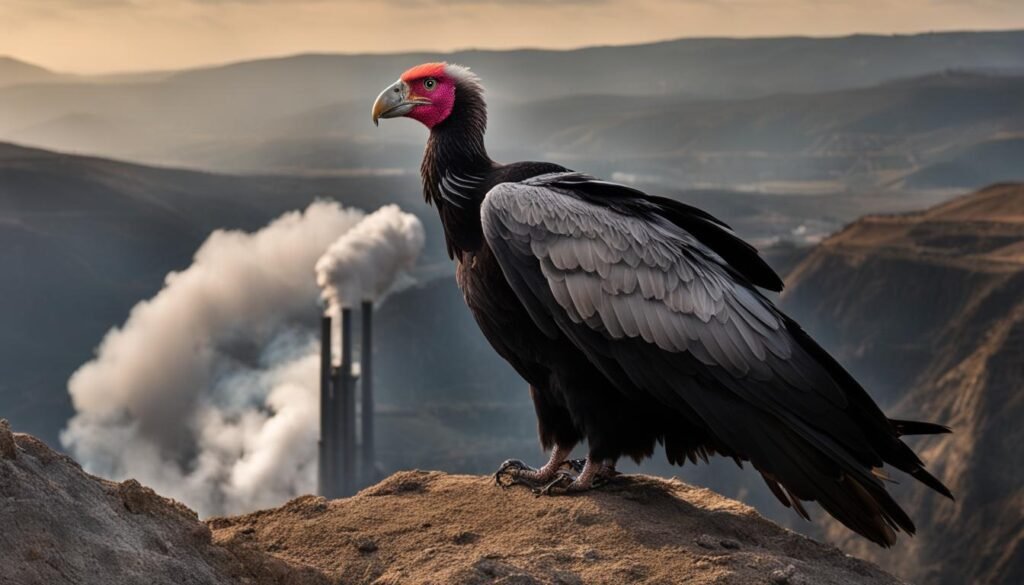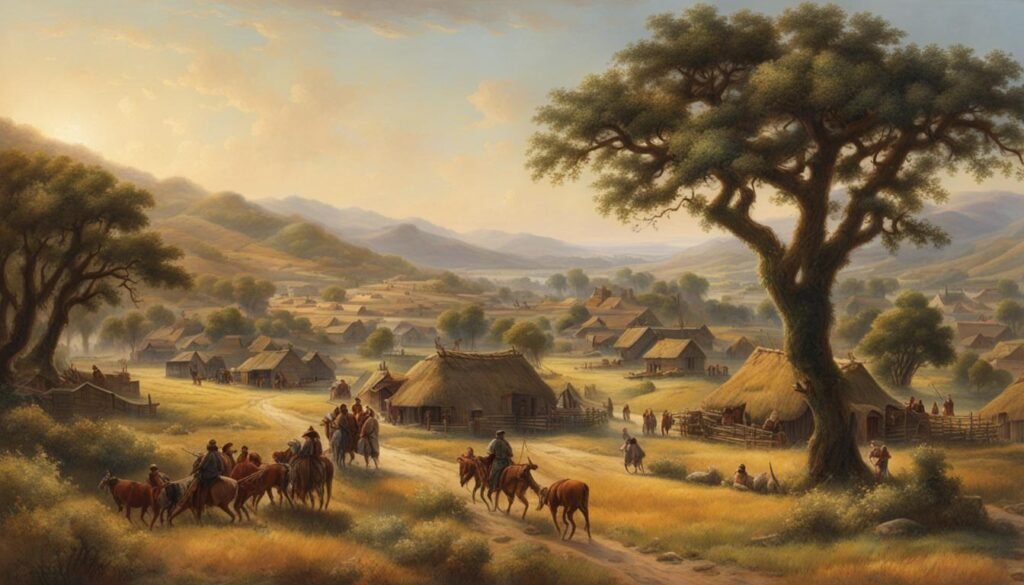As a wildlife enthusiast, I am thrilled to share some exciting news about the majestic California condor making a remarkable comeback in the beautiful landscapes of California. These magnificent birds, also known as the condors, were once on the brink of extinction but have now started reclaiming their rightful place in the skies.
The reintroduction efforts by the Yurok Tribe’s Condor Restoration Program, in collaboration with the U.S. Fish and Wildlife Service, have been instrumental in the condors’ return to their historic habitats. Recently, two juvenile condors were released in Northern California, marking a significant step towards expanding their range.
Key Takeaways:
- After a century-long absence, the California condor is making a remarkable comeback.
- The Yurok Tribe’s Condor Restoration Program and the U.S. Fish and Wildlife Service are reintroducing condors in their historic territories.
- Organizations like the Oregon Zoo and Ventana Wildlife Society have played crucial roles in breeding and raising condors for release into the wild.
- Conservation efforts have resulted in the global condor population increasing from 22 in 1987 to approximately 500 today.
- The protection of condors and their habitats is crucial for overall wildlife conservation.
The Conservation Efforts for California Condors
The resurgence of California condors is a direct result of dedicated conservation efforts. Several organizations, including the Yurok Tribe’s Condor Restoration Program, Oregon Zoo, and Ventana Wildlife Society, have played instrumental roles in these initiatives.
To ensure the preservation of condors, these conservationists have focused on various strategies:
- Habitat Preservation: Protecting the natural habitats of condors is crucial for their survival. Efforts have been made to safeguard these areas and mitigate potential threats.
- Captive Breeding Program: Implementing captive breeding programs has been instrumental in increasing the condor population. Organizations like the Oregon Zoo have successfully bred and raised condors for release into the wild.
- Species Recovery: By closely monitoring the condor population and their movements, conservationists have been able to identify and address potential risks. Regular health check-ups and necessary interventions have contributed to the overall recovery of the species.
- Wildlife Management: Managing the condor population and studying their behavior have provided valuable insights into their ecological needs. This knowledge enables better wildlife management practices to ensure their long-term survival.
Through collaborative efforts, these conservation organizations have made significant progress in protecting and recovering this endangered species. Their dedication to wildlife management and species recovery is commendable.
California Condor Facts and Characteristics
The California condor, Gymnogyps californianus, is a remarkable bird with unique characteristics. This ancient species once had a vast historic range during the Pleistocene Epoch. Unfortunately, various factors such as climate change and environmental toxins have significantly reduced their range over time.
However, recent reintroduction efforts by the Yurok Tribe have marked a significant milestone in expanding the condors’ historic range to the Pacific Northwest. These majestic birds, known as the California condor, are one of the largest bird species, boasting an impressive wingspan of up to 10 feet. With their distinct black feathers, bald head that turns pink in adults, and regal stance, they are truly captivating creatures.
The California condor has a remarkable lifespan, with some individuals living up to 60 years. Despite once being on the brink of extinction, these birds have shown great resilience and adaptability.
As the scientific name suggests, Gymnogyps californianus, these birds are native to California and have played a significant role in the state’s ecosystem throughout history.
Key Characteristics of the California Condor:
- Ancient bird species with a rich history
- One of the largest bird species
- Impressive wingspan of up to 10 feet
- Distinct black feathers and a bald head
- Lifespan of up to 60 years
- Scientific name: Gymnogyps californianus
These unique characteristics make the California condor a symbol of wildlife conservation efforts and a testament to the importance of protecting vital condor habitats for their continued existence.
The Significance of Condors in California’s Ecosystem
California condors hold immense importance in maintaining a balanced ecosystem in California. As the state bird of California, their presence plays a crucial role in wildlife conservation and the overall health of the environment.
One of the key contributions of condors is their role as scavengers. These majestic birds primarily feed on carrion, helping to remove decaying carcasses from the environment. By doing so, they prevent the spread of diseases and maintain the cleanliness of their natural habitat.
Additionally, condors help regulate the population of other scavengers, such as vultures and coyotes. Through their scavenging activities, these magnificent birds maintain a healthy balance in the ecosystem, ensuring that no single species becomes overly dominant.
Several areas in California serve as natural habitats for condors, including Pinnacles National Park, Big Sur, and Ventana Wilderness. These protected areas provide suitable environments for condors to thrive and carry out their essential ecological roles.
By protecting condors and preserving their habitats, we can contribute to the overall conservation of bird species and wildlife in California. This includes efforts to safeguard the natural beauty and biodiversity found in iconic locations like Pinnacles National Park, Big Sur, and Ventana Wilderness.
The image above depicts a breathtaking scene from one of these natural habitats, highlighting the magnificence of condors and their significance in California’s ecosystem.
Threats to California Condors and Conservation Measures
Despite the successful recovery of the California condor population, they still face significant threats. One major challenge is lead poisoning, primarily caused by ingesting lead fragments from animals killed with lead ammunition.
Conservationists have been working tirelessly to raise awareness about this issue and encourage hunters to switch to copper ammunition, which is less harmful to condors and other wildlife. By reducing the use of lead ammunition, we can minimize the risk of lead poisoning and protect the health of these endangered birds.
The wildlife protection measures put in place for California condors go beyond lead poisoning prevention. Conservation efforts are focused on preserving the condor’s natural habitats, ensuring their continued survival. Ongoing conservation efforts are essential in maintaining a stable population of these majestic birds and safeguarding their ecosystem.

Conservation Measures for California Condors:
- Promoting the use of copper ammunition to reduce lead poisoning risks
- Preserving condor habitats through land conservation initiatives
- Monitoring and tracking condor populations to better understand their behavior and needs
- Collaborating with local communities to raise awareness about the importance of wildlife protection
- Supporting research efforts to develop innovative solutions for condor conservation
By implementing these measures and continuing to prioritize wildlife protection, we can secure a brighter future for the California condor and ensure their long-term survival as a treasured symbol of our natural heritage.
The Role of Zoos in California Condor Conservation
Zoos have played a vital role in the conservation of the majestic California condor. Institutions like the Oregon Zoo and the Santa Barbara Zoo have been actively involved in the breeding and raising of condors as part of their efforts to support the species’ recovery and ensure their survival in the wild.
Through carefully managed breeding programs, zoos have contributed significantly to the increase in the California condor population. These programs aim to maintain genetic diversity and increase the number of viable individuals for release into their natural habitats. Moreover, zoos play a crucial role in raising public awareness about the importance of condor conservation and the challenges faced by these magnificent birds in the wild.
By showcasing condors and providing educational experiences, zoos help engage visitors in bird conservation efforts. Through up-close encounters, people develop a deeper understanding and appreciation for the natural world and the need to protect endangered species such as the California condor.
Zoos: Promoting Bird Conservation and Ecosystem Preservation
- Zoos actively participate in captive breeding programs, carefully pairing condors to optimize genetic diversity and ensure the long-term survival of the species.
- These programs are essential for providing a stable population of condors, which can be reintroduced into the wild to supplement existing populations or establish new ones.
- Zoos also collaborate with other institutions and conservation organizations to exchange knowledge and expertise in condor husbandry, healthcare, and breeding techniques.
- Furthermore, zoos contribute to scientific research through the collection of valuable data on condor behavior, reproduction, and overall health, aiding in the development of effective conservation strategies.
- Through their commitment to conservation, zoos play a critical role in wildlife protection and the preservation of ecosystems, ensuring a future where the California condor thrives.
The efforts of zoos serve as a testament to the significant impact they can have on bird conservation and the preservation of endangered species like the California condor. By continuing to support and collaborate with zoological institutions, we can work towards a brighter future for these magnificent birds and their habitats.
The Future of California Condors
The future of the North American condor, also known as the Condor de California, depends on our collective commitment to wildlife conservation and species recovery. While significant progress has been made in increasing the condor population, these majestic birds still face various threats and challenges.
Preserving the condor habitats is essential for their long-term survival. These habitats provide the necessary resources and conditions for the condors to thrive. By protecting their natural environments, we ensure that the condors have access to suitable food sources and safe nesting areas.
Ongoing captive breeding programs have been instrumental in boosting the condor population. These programs, implemented by organizations like the Yurok Tribe’s Condor Restoration Program, have successfully bred and raised condors for release into the wild. By continuing these efforts, we can further support the recovery of the condor species.
Lead poisoning remains a significant concern for condors. Efforts to reduce lead poisoning, such as raising awareness about the dangers of lead ammunition and promoting alternative options, are crucial. By minimizing the ingestion of lead fragments, we can safeguard the health and well-being of condors and contribute to their population recovery.
Protecting condors and their habitats requires collective action and collaboration. Through community engagement, conservation organizations, and government support, we can ensure the continued existence of these extraordinary birds. By working together, we can secure a brighter future for the North American condors and make a substantial impact on wildlife conservation efforts.

The Continued Journey Towards Conservation
The path to preserving the North American condor and its habitats is ongoing. It requires sustained efforts to address the challenges that threaten these beautiful birds and their ecosystems. By remaining vigilant, raising awareness, and implementing effective conservation strategies, we can safeguard the future of the condors and ensure the protection of our natural heritage.
Conclusion
The resurgence of condors in California is a testament to the power of conservation efforts and the collective dedication of various organizations and communities. The California condor population has experienced significant growth through habitat preservation, captive breeding programs, and ongoing conservation measures. However, our work is not done, and we must continue to protect the condors and preserve their habitats for the future.
By supporting bird conservation and wildlife protection initiatives, we can contribute to the recovery of endangered wildlife and ensure a thriving ecosystem. The California condors symbolize the importance of preserving our natural heritage and the need for responsible stewardship. Through continued collaboration and education, we can create a sustainable future where condors and other endangered species thrive.
Preserving the condors in California goes beyond protecting a single species. It is about safeguarding the delicate balance of our ecosystems, promoting biodiversity, and ensuring the resilience of our natural habitats. Together, let us work towards a future where the skies of California are filled with the graceful flight of condors, and where wildlife conservation is a priority for generations to come.
FAQ
What are the key conservation efforts for California condors?
The key conservation efforts for California condors include habitat preservation, captive breeding programs, and species recovery initiatives.
What are some facts and characteristics of California condors?
California condors are one of the largest bird species with a wingspan of up to 10 feet. Their lifespan can reach up to 60 years, and their scientific name is Gymnogyps californianus.
What is the significance of condors in California’s ecosystem?
Condors play a vital role in maintaining a balanced ecosystem. They are considered the state bird of California and help control the population of scavengers, ensuring a healthy environment.
What are the threats to California condors and what conservation measures are being taken?
Lead poisoning is a major threat to California condors. Conservation measures include raising awareness about lead ammunition and encouraging hunters to switch to copper ammunition. Wildlife protection efforts also focus on preserving condor habitats.
What is the role of zoos in California condor conservation?
Zoos play a crucial role in breeding and raising condors for release into the wild. Institutions like the Oregon Zoo and the Santa Barbara Zoo have contributed to the increase in the condor population through captive breeding programs.
What does the future hold for California condors?
The future of California condors relies on continued conservation efforts and collective action. Ongoing habitat preservation, captive breeding programs, and the reduction of lead poisoning are crucial for their long-term survival and recovery.
What is the significance of the resurgence of condors in California?
The resurgence of condors in California is a testament to the power of conservation efforts and the collective dedication of various organizations. By supporting bird conservation and wildlife protection initiatives, we can ensure the recovery of endangered wildlife and a thriving ecosystem.







